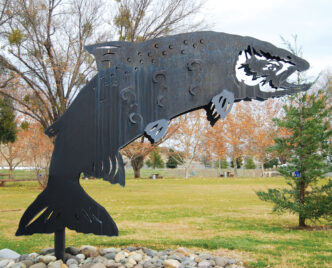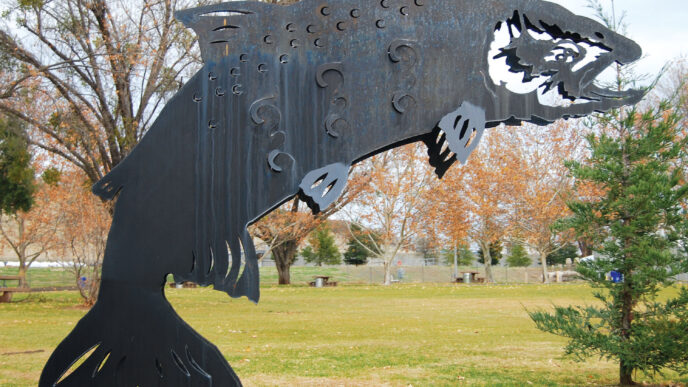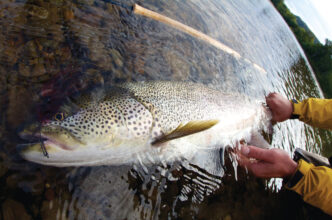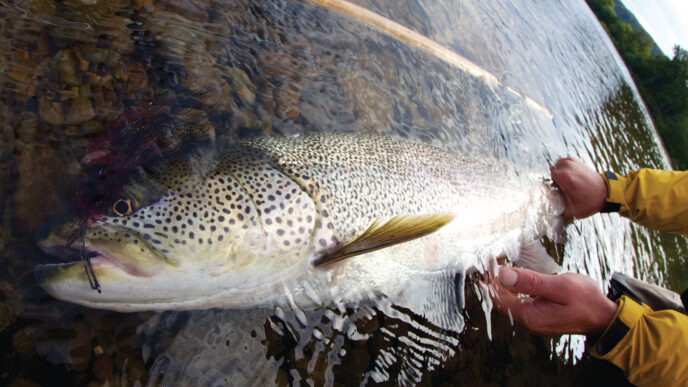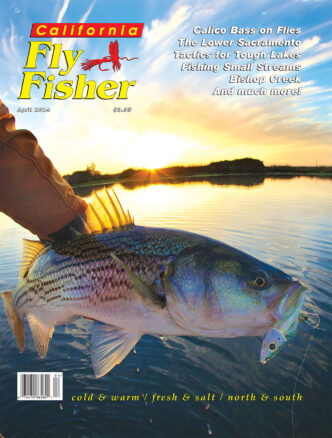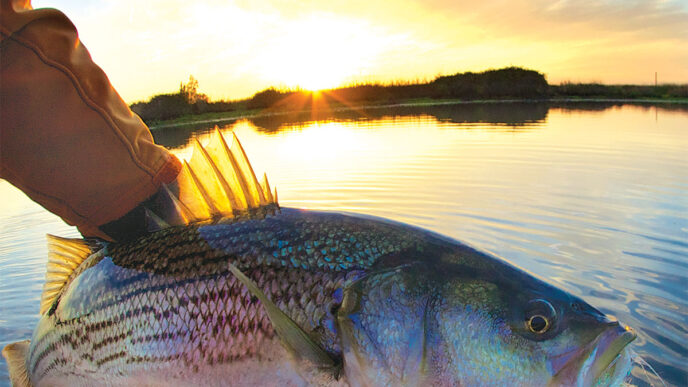We’d bushwhacked the icy bank of a closed-to-fishing tributary for three or four hundred yards, spooking spawning salmon and two poachers, so it was dispiriting to hear voices from behind a copse of alders that marked our destination at the stream’s confluence with the river, which was still open. Very disappointing, particularly because the pool there lies below a long stretch of marginal water, and cliffs prevent access downstream.
We’d risked the hike and lost.
Steve turned to eyeball me. I grimaced. “Better cut over,” I said, nodding toward a thicket of deadfalls and blackberries we’d need to bust to cross the peninsula. “I’ve never seen much fishable water up there, but things change.”
“We’ll find something.”
Finding something is a challenge when fishing coastal rivers for anadromous runs. Fish, first — runs that are either there, though in numbers that vary wildly or that are absent completely if you’re early and rotting on the shore if you’re late. Next comes place. If fresh salmon are in, for example, so are anglers in abundance, which hereabouts includes some who see regulations as f ru-fru written for folks too wimpy to carry clips on their camo belts.
Escaping the crowds around well-known holes requires trekking to smaller, marginal spots, but these present another set of problems. Fall and winter spates, especially the extreme floods of recent years, alter the landscape so radically that my favorite run is now filled by silt descended from avalanches beneath clear cuts, and the second favorite is a dry gulch lying fifty yards from the river’s new channel.
The opposite can happen, of course. And luckily this day, things had changed since my last visit. Another bushwhack brought us to a spot where a hundred-foot fir has fallen across a riffle, backing up currents to create a run that at one edge eats into a bank before pouring over the root ball. It looked good, with all kinds of interesting angles to fish, but was occupied by what looked like a father and his two sons who must have walked down from upstream.
Back into thickets again. Then, to my surprise, we needed to wade, first through a swampy slough, then across a larger braid in the river stem that hadn’t been there before. Salmon had entered this and were in a shallow pool just above us, also in another above that.
Steve went on point. “Heading up there,” he said softly. But I liked a seam I saw in the main stem, where the braid spilled in below a thin cobble spit, and — much like the father and sons’ spot — another fallen tree had backed up current downstream.
“Later,” we said.
I’d left home in a rush, so by the time I’d set up — then the damn line broke at the nail knot — Steve already had cast his way well up to the second braid pool and looked to be fishing fast.
Rerigging on the water is certainly a pain, but the delay gave me time between curses to observe, and the cobblespit looked better and better. I’d stayed back and crouched low, so salmon slipped past me every few minutes. I also noticed that a sandy ridge had built up where slow water met fast. Greenbacks boiled at the surface near its tail end and occasionally boiled all the way down to the deadfall. I like this spot a lot,I thought.
I still did, an hour and half later. I’d spent almost fifteen minutes of that time landing a buck of about sixteen pounds, fresh enough to jump repeatedly, also ten minutes apiece on smaller females. Three brutes had torn free or broken off on runs I’d had to pressure too hard for fear of branches downstream, but I wasn’t complaining.
In fact, I even had time to wonder how Steve was doing — well, I presumed, until the father appeared, to fish the braid pools above me without success. And if the river above hadn’t changed from previous years, what had Steve found?
Friendship trumped the spirit of, We’re Getting Away from It All, so after begging forgiveness from the Wild Gods, I tried to call him on my cell phone, and when that failed, I sent a text: “Lots of fish where you left me. LOTS.”
Man, the Wild Gods are tetchy. Both of my fish in the next half hour were foul hooked hens too stuck to shake, so my arms and shoulder were already aching when I finally saw Steve stride round the river bend above. The good part of that was it made things easy when he told me he’d not gotten my message and that “so far, it’s been a fine day for casting.”
“Prodigal son,” I said grandly, already reeling in. “Stand right here. Let the rumpus begin.”
There was room for only one on the spit, so naturally, Steve objected. Naturally, I persevered, presenting him with a variation of the “Alligator!” trick. “Listen, when it ’s cold like this, I have to watch my health. Another buck battle and . . .” I tapped my chest and looked solemn. “Is it too much to ask that you save me from myself?”
Steve did not seem convinced. At all. “I mean it,” I said emphatically, then continued in a more conversational tone. “And I’m pretty sure that if you roll your eyes like that in weather like this they can freeze staring straight back into your head.”
I made that up. But here’s a fact:
Although it’s often only the excuse of a less able angler envious of another one’s success, sometimes there really is a spot, one and only, where one or more fish factors come together in a way that makes all the difference. I’m not talking prime lies now — a perfect pocket that always holds a brown trout or a boulder in some classic steelhead run — but places that either concentrate every fish or create conditions so special they are the only place where you can catch any. Forget that magic fly, lure, or bait, and never mind superior presentation: nothing in your skill set or arsenal matters. You’re there or nowhere.
In the worst of these scenarios, an eighty-year-old with a Zebco and Snoopy bobber towing a maimed plastic allosaurus will kill ’em while every other angler in the zip code twiddles expensive tackle and eats skunk.
Maybe you’ve been that kid. Or maybe you were a twiddler who, after keeping a polite distance for two hours, as is proper for a mature and mannerly angler, suddenly pointed at a submerged log and shouted “Alligator! Alligator! Run for your life, child, while I hold him off!”
One way or the other, if there’s a fisher who’s never thought he or she could score “if only I were standing there, ” I bet he’s casting a living bough of Buddha’s bo tree. That wouldn’t be me. But when Steve finally agreed to take “a few casts” from the spit, I found an alligator log to sit on and the time to contemplate other One and Only spots — where and when I’d found them and the factor or factors I figured made them special.
I watched him miss a few hits in the next half hour. I also declined his repeated invitations to take the spit back, assuring him I was fine. And because I was fine, not at all desperate to get back to catching, I began to wonder Why not? It wasn’t great grace that kept me seated, and my arms and shoulder felt fine so . . . ?
It took a few minutes to frame a certainty I’d never considered from this angle: some One and Only spots are thrilling, others less so, or not for long.
Like this one, for example.
I knew that was true as soon as the thought struck. Figuring out why took a while and a little walk through history.
Let’s call them “O & OS.” My first was built into the home water stream I angled as a kid. I’m stretching the idea of stream: we’re talking one of the open, dirt banked irrigation ditches that crosshatched the Phoenix landscape in the mid-twentieth century. Mine was roughly five feet wide and four deep. For three days every two weeks, it ran full, straight as a die from Camelback Road down TwentyEighth Street. The rest of the time, it lay empty. “Angling” is also a push: when the water went down, I waded in muck, clutching an empty jelly jar, lunging at mosquito fish, polliwogs, crawdads, the occasional baby bullhead, and, once in a blue moon, shad that washed down from one of the Salt River reservoirs.
Not exactly the Catskills or a pristine Sierra stream. In fact, only one spot on that mile mattered: a tiny pond behind a steel gate, where flows had dug out a depression that briefly held water after the rest of the ditch dried up.
A modest venue, maybe. Not so the lessons it taught me.
Every seven-year-old knows that “fish need water,” but I soon learned that there is more to this than staying wet. Depending on size and species, the fish had preferences about where in the water they wanted to be: while small fish fry would stay in the shallows, even in the open sun, everything bigger tried to stay deep and in shadows whenever they could. Cooler and safer made sense — and maybe the little fish needed to stay away from the larger?
In theory, this situation meant I’d catch my best prizes as evaporation drew the level low enough that I could see and catch them. But that didn’t always work out. If you waited too long —if you missed a day for baseball practice — you might return to find that while enough water remained for fish to swim, many were dead — any shad, for sure, and most the fish fry and polliwogs. And if that missed day was too hot, even the baby bullheads were floating belly up.
Wet, but kaput. Why?
It took my father to figure this out, indirectly, and explain the mystery to me. This happened when I presented him with a big school of dead minnows I’d kept in a jam jar for four days, a major catastrophe. “They ran out of oxygen,” he told me.
Oxygen, as in air?
“It’s also in water. Dissolved. They breathe it through their gills.”
That sounded highly unlikely, but turned out to be true. Also important, one of those exigencies that make a difference, and . . .
You can see where I’m going with this.
It doesn’t take magic to find fish, either in ones or twos or en masse, though sometimes it seems that way or would be easier if that were true. Instead, most of us spend years learning to recognize and exploit factors that govern fish behavior. Food, temperature, light, depth, shelter from predators, sufficient current or relief from that stress: the list goes on, and by the time you’ve studied a dozen species-specific preferences, we’re talking an education in mysteries more demanding than the Hogwarts curriculum. This study isn’t just critical to catching, it’s also one of the reasons why fishing’s worth doing. And though O and O’s aren’t the place this happens, they are sometimes outsized examples that add to our education.
Certainly, Lashley’s Tree did that for me several times over. I failed my first semester on the lake where I worked at a campground for room and board. At least, I’ll give myself a C minus. That was the summer when I decided one piece of tackle made all the difference — the obvious reason that ancient Old Man Lashley, perched every morning at the stern of a long boat permanently chained to a tree on a short shoreline where half the lake’s anglers collected, outscored everyone and sometimes outfished half a dozen put together.
It had to be his reel. While I couldn’t see how the old Humphrey’s Denver, an odd-looking, stainless steel anomaly that let line slip out sideways, at right angles from his old fly rod, could make such a difference, at fourteen years old, I knew everything would be different if only I had one just like it.
By the next year, I was wiser. I still coveted his Denver, but a cast was a cast, and Lashley’s were no longer — and usually shorter — than others could make with spinning rigs, always straight out in front of him from his seat at the stern. So bait was the answer, I figured. While everybody else tipped hooks with salmon eggs, egg-and-corn-kernel combos, worms, or wads of Velveeta, Lashley mixed up his own — dough balls to which he added “secret” ingredients, sometimes including ground beef. Maybe, but these were stocked trout, rainbows often fresh from a truck. I also noticed that Lashley’s rig wasn’t quite identical to everybody else’s. I’d thought he used a cork bobber instead of the standard plastic bubble just because he was, well, old, but it just might be important that his dropped down more gently, without the kind of crash that continued to ripple for a full minute.
Perhaps you’re wondering why the importance of the spot he was fishing had not occurred to me. It had. But that possibility wasn’t persuasive. Others lined up as close to him as was polite, sometimes closer, but except for the tree and the fact that the stern of his chained boat extended ten feet out into the water, there was nothing about his part of the bank that looked any different from the shoreline around it, a featureless slope of fifteen or twenty degrees without any special definition.
Lashley died that winter. When I returned the next year, only the chain around the tree remained, because his widow couldn’t find the key. She’d sold his trailer to the campground owner, along with the clothes her husband had left inside. I inherited a pale green coat, and then, from my boss, a little legacy of information.
The lake was natural, but some years before, a small dam had been built at one end. Nobody was sure if Lashley had fished there before this happened, but what was certain was that high water now obscured some of the original contours of the lake completely. One of these was a narrow finger that curled out of a larger channel, cutting through what had been a broad flat. And the tip of that finger, of course, pointed straight to the trunk of Lashley’s Tree.
Always straight in front of him, those casts.I remembered now that on occasion, he would adjust the position of his bobber after it fell, reeling in slowly, then letting it sit, probably right on the edge of a dropoff only he knew was there, an O & O that likely had lots to do with depth and temperature, the movement of fish still learning to feed on subsurface bugs that still knew to keep close to the security of dark water.
Fortysomething years later, I bet I could list fifty 0 & Os of one kind or another. A few are spectacular — this deep-blue hole, maybe a cenote, set into a Yucatan bonefish flat; a reef just off a broad beach near Encinitas, invisible from shore; a drowned roadbed running along a reservoir bottom, where bass lined up like cabs on at an airport. Some are transient, created by tides or currents in the bay or by the time of day, like a shallow shelf in the lake down the hill, a place that’s too full of boulders for a bass boat and that fills with smallmouths hunting crayfish on summer evenings. Many are natural anomalies — seamounts rising from the ocean depths, or a tangle of floating kelp drifting a mile out in the Sea of Cortez. Man makes a few — accidentally, with dams or diversions, or in special events, such as dumping stunned rainbows in warmwater lakes, ringing dinner bells for giant largemouths and channel cats, and occasionally deliberately, as I witnessed while fishing a breakwater somewhere below Eureka, catching perch until a big family arrived to empty a pair of sixty-gallon drums full of crab parts into an area they colonized, effectively chumming into their own range every rockfish around.
Without doing the math, I’d guess that a concentration of food is the most common O & O denominator. And after examining the thoughts that prompted this reflection, I can honestly say that with a few exceptions, I’m as eager to find and exploit these opportunities as any angler. Fooling fish with flies they think are food is what we’re about. That’s fair, plain and simple. It’s when spawning causes concentration — when fish aren’t eating at all — that I start to get uneasy.
That’s always been the case, even before I knew much about critical conservation issues. I met my first live salmon on my first trip to Mill Creek in 1979. A pal and I had been fishing for trout — the only game fish species we knew lived there — and had just climbed around a waterfall when a chinook breached in the pool below. I stood there, stiff and stunned — salmon didn’t even occur to me until two others broke the surface — then I spotted the dark shapes of a school, a dozen fish that looked to me between twelve and twenty pounds. While I’d taken a pair of steelhead from the Eel five years before, I’d never seen fish of this size in a stream so small. And they were beautiful. As lovely as trout, but magnificent.
I was still mesmerized when my partner scrambled down beside me, and for fifteen or twenty minutes, we might have been gargoyles. I don’t think it occurred to either of us to make a cast all that time, and when we later contemplated why we hadn’t, the idea seemed almost ignoble, at very least unclean. Given the extraordinary lives they’d lived, the hazards they’d survived to reach this place, and the purpose they pursued — this waterfall they must, somehow, leap on their way . . .
We might have felt differently if we’d been kids with something to prove, or had kids to feed, or were sure that salmon would survive catching and releasing. Since none of these applied, pressuring survivors of such hazardous lives — fish already a hundred miles up f rom the ocean, now facing this waterfall and whatever lay upstream on their way to a single great act of perpetuation . . .
… for sport . . .
Much later, we’d find out how endangered Mill Creek chinooks were in those days, but at the time, I remember expressing a more personal and frankly anthropomorphic reaction. With the possible exception of a romantic partner’s immediate family — I might have had moment with a girlfriend’s father or two — anybody interrupting my own practice spawning would face violence, and if, for fun, some prankster interfered with my only chance to have sex and produce offspring, he would die without issue of his own.
I’m still good with that. And it was almost a decade before I hooked salmon on a river, accidentally, while fishing for steelhead on the Feather, where I landed a pair of not completely dead hatchery kings from a run near Oroville. I’ve a picture of one that warped the spool of a fly reel, a fish held up by a guy who swore it weighed more than fifty pounds. That was some fight, but a guilty pleasure, and on two trips to a stretch below the diversion dam, I found myself nonplussed by conditions that made hooking — or foul hooking — salmon too easy to feel satisfying, if that was what I was trying to do. Far better to target the small steelhead edging up on the redds — fish I figured were eating — or even the squawfish, whose appetites were never in question.
Silver salmon in the salt came next, in Southeast Alaska, where I confess to pursuing them a few hundred yards up streams where, feeding or not, they chased and struck streamers savagely. The pinks were another story — not even tempting me in streams where their schools smothered the bottom, so abundant that even the bears seemed bored.
I’ve gone to hell since then, though not too often, usually for silvers, and occasionally for chums within a few miles of the salt. And chums are what Steve and I were after on my home river, a mixture of native and stray hatchery fish that combine in a run still healthy enough to target, partly because few anglers bother to do so. There are several reasons for this neglect. Most consider chums, aka “dogs,” marginal cuisine, as salmon go, almost worthless when they enter fresh water. Some anglers dismiss them as fighters (presumably those who’ve never caught one or only reeled in a carcass). Then there’s the fact that “healthy” runs here don’t mean “heavy,” more like hundreds of fish per mile than thousands. Finally, while spawning chums have a reputation as “snappish” — the local gear fishers use jigs or Corkies dead drifted beneath bobbers — most fly fishers swing sinking or sinktip lines, a technique that prompts heated discussions about “flossing.”
Nobody denies this happens often. At the same time, many insist that dog salmon are often more particular about flies than the other salmons, preferring small streamers sparsely tied, and that colors can make all the difference — either pinks or assorted greens, typically deeper and darker than chartreuse.
Fly selectivity argues that chum strike, and that has been important when I’ve fished them. But since that’s not a regular habit, and because I’ve watched them hang on the bottom opening and closing snouts the size of border collies’, I’m not convinced a buck has actually bitten, even when my hook’s set in its jaw or in the mouth behind those teeth. You can’t know. You can avoid deep sweep-and-jerk retrieves, then hope the take was fair.
Unless none are, quite, ever.
However they get onto your hook, these salmon aren’t eating — at least not lures that look like baitfish or shrimp. Even if fly size and color matters and every “bite” is a strike, catching fish interested only in spawning still chafes me. Chums may not be as lovely and magnificent as Mill Creek chinooks, though I happen to think they’re great-looking animals, especially the snarling bucks, barred and colored like an artist’s conception of an allosaurus in a book I loved as a boy. But their journey is also remarkable, their mission-critical, and even if a catch and careful release is only one more obstacle they will overcome . . . hey.
It could be just me that feels that way, that I’m splitting hairs and getting too anthropomorphic. (I am.) But there’s another reason I was content to sit and watch Steve, more excited by the idea of him catching a fish than of me a catching another. Standing in the same place, making the same casts, because you’ve got a spot wired, getting bumps every time, almost, landing hens of two sizes — however big and strong — is at very least predictable. Tiring, too. And while it seems ungrateful even to think the word, after two or three hours . . .
I’ll let you fill in that word, for fear of the Wild Gods. Also because Steve had come a little late in the day, so had tugs, but by eventide had brought nothing to hand. The bushwhack out was brutal and cold, the ride home a tiny bit awkward, because that’s what happens if somebody hits an O & O and anotherbody doesn’t, though Steve and I don’t struggle with that very much. But unlike me, he wasn’t done. The next day, I got a photo he’d attached to a text — “Went back.”
“Figured you would,” I replied. “Beautiful buck.” Then, in an after text, I sent “Same place?”
“Same place.”
Rare as O & Os are, I wasn’t even tempted.
Maybe next year, maybe not. Hard to say. Many factors create O & Os, modest or phenomenal. In time, and with effort, we may puzzle these out. But the factors that form fishers who spend lifetimes studying secrets of fish, and waters, and wiser anglers — who wade ditches, risk freezing hikes, bust brush to cast in the cold, and, failing, go back again to try again. . .
Those remain mysteries. Magical, at least.






